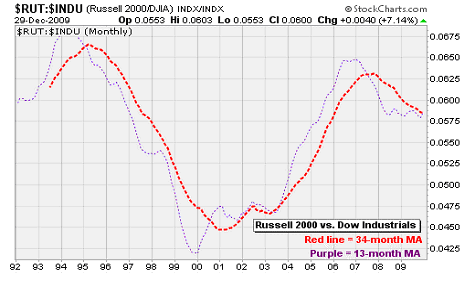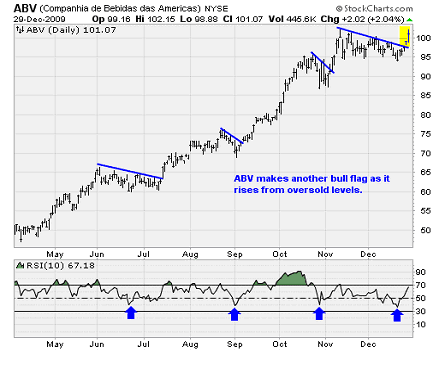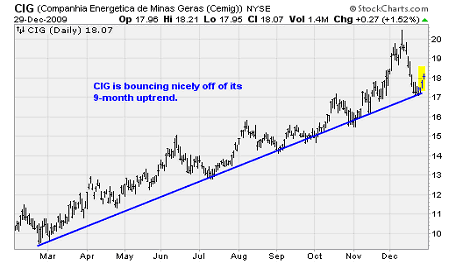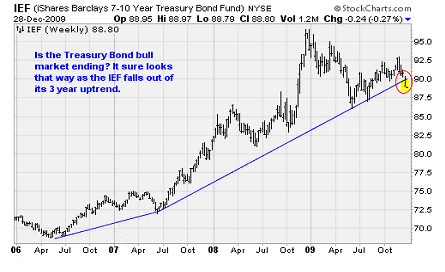Which Sectors Will Lead the Stocks Bull Market During 2010
Stock-Markets / Investing 2010 Jan 04, 2010 - 05:01 AM GMTBy: Money_Morning
 Jon D. Markman writes: Digging beneath the surface of the late 2009 market for clues, we find that some measures of breadth continue to deteriorate even as the major indices continue to float near their highs. For example, the percentage of stocks above their 10-day moving average has gone from 81% on Christmas Eve to 71% now. This is an indication that buyers have become more selective.
Jon D. Markman writes: Digging beneath the surface of the late 2009 market for clues, we find that some measures of breadth continue to deteriorate even as the major indices continue to float near their highs. For example, the percentage of stocks above their 10-day moving average has gone from 81% on Christmas Eve to 71% now. This is an indication that buyers have become more selective.
This adds to a trend that's been developing over the last few months. While the NASDAQ Composite Index has managed an impressive breakout from its multi-month trading range, it's doing this on the back of fewer and fewer stocks based on the number that are over their 50-day moving average. Part of the problem is the lack of clear market leadership.
One of the reasons that the bull cycle of the past year has been so strong is that it had a rotating cast of leaders: First banks, then retailers, then tech, then energy, then materials, and so on.
Right now, aside from today's impressive move in semiconductors and possible early signs of strength among brokerage stocks, there isn't any major sector group rearing back like it's about to enter a new upswing. Materials and energy looked really strong until about two days ago as traders seemed to decide the dollar's resurgence isn't a short-term wiggle but the beginning of something bigger.
If the bulls are going to push a group higher, they need to hurry up and get the job done as the broad market looks increasingly top heavy. We can't make any hard-edged decisions at the moment with volume so light, but we'll be watching closely for clues when the market comes back early next week about which sectors and which stocks are likely to lead the charge in early 2010. My expectation at this point is that tech, and particularly semiconductors, will assert a leadership role. If that does happen, it will be a huge positive for the whole market.
Small Caps Have Fuel to Burn
Market gains in the last two weeks of the year were driven overwhelmingly by a withdrawal of selling pressure rather than an increase in buying demand. According to Paul Desmond of Lowry Research, his gauge of buying power increased just 4 points in December compared to the 24 point drop in his selling pressure measure.We'll be looking for evidence of improved demand as the calendar flips into January. It tends to be one of the strongest months of the year for the smaller, riskier stocks in the NASDAQ and Russell 2000 indices. Gains here should force institutional investors off the sidelines. Based on 30 years of historical data compiled by Jeffrey and Yale Hirsch, the father and son team behind the Stock Trader's Almanac, small stocks tend to outperform strongly between December and March with a small pause in mid-January.
It's possible that the pause we saw in December was a time-shifted January pause. As these seasonal patterns are more widely recognized, they move back in time as traders try to capitalize on them early. Eventually, they can disappear completely for a time just to throw everyone off the scent -- which frequently happens with the 40-week cycle that we have frequently discussed.
Another factor to consider is that at the start of all the major bull markets of the last 30 years, smaller stocks significantly outperformed larger, safer stocks during the earliest phases before large caps assume the leadership role as the upswing matures. It happened in the early 1980s. It happened in the early 1990s. It happened in 2003 through 2005. And it appears to be happening again now.

Evidence suggests that this small-cap outperformance is far from finished in the current cycle. Take a look at the chart above. What you are seeing is the 13-month (purple line) and the 34-month (red line) moving averages for the relative performance of the Russell 2000 small cap index to the Dow Industrial Average large cap index. Coming out of both the 1991 and 2001 recessions, the 13-month line moves well over the 34-month line as smaller stocks pushed upward, in a sign of strong momentum.
Right now, the 13-month line has yet to cross the 34-month line. But it will. And this suggests that smaller stocks have plenty of fuel left in the tank. We recently recommended fresh exposure to small caps via a position in the Vanguard Small Cap ETF (NYSE: VB) fund.
Red-hot Brazilian Stocks
During December, we saw foreign stocks, especially those in China, struggle as American stocks jumped to new highs. The popular iShares FTSE/Xinhua China 25 Index ETF (NYSE:FXI) has lost 9.4% since it set a high in November. In comparison, the Russell 2000 has gained 14.4% since early November. This is part of the reason why we have trimmed exposure to foreign holdings.We've recommended retaining a 15% allocation to Latin America and Brazil, however, for a very simple reason: They continue to find buyers. And there's nothing more bullish than rising prices.

One to look at is one of our long-term holdings, Companhia de Bebidas das Americas(ADR NYSE: ABV), a beverage company focused on the production and distribution of beer, soft drinks, across 14 countries in the Americas. Better known as AmBev the company bottles Pepsi products outside the United States, with operations throughout Canada and Latin America, including Ecuador, Peru, and Bolivia.

Another is Companhia Energetica de Minas Gerais(NYSE ADR: CIG) or CEMIG, which we've also recommended several times in the past year. The energy company mainly generates and distributes electricity but is also involved in natural gas distribution, telecommunications, and business consulting. It's majority owned by the government of the state of Minas Gerais, the second most populous and the fourth largest of the 26 states in Brazil, where it provides power to six million people.
U.S. Retailers Perk Up
Big-box retailers' stocks were disappointing in the past week after MasterCard Advisors' Spending Pulse latest data showed holiday sales increased 3.6% over last year. Compare this to the 2.3% drop of last year. Excluding the extra shopping day between Thanksgiving and Christmas, the gain was closer to 1%. Still, considering fears that the big snowstorm would freeze out Northeast shoppers, it was an acceptable result.Digging deeper, the best selling holiday items according to the data were consumer electronics (up 5.9%), footwear (up 5%), and jewelry (up 5.6%). The last item is just another indication that consumers' recessionary mindset is fading: Last year, sales of jewelry -- the ultimate in discretionary purchases -- fell 30%.
Investors were impressed enough to boost the shares of teen retailers American Eagle Outfitters (NYSE: AEO) and Urban Outfitters Inc. (NASDAQ: URBN). The latter hit a new one-year high and is a hug and a kiss away from a new all-time high. Amazon.com Inc.(NASDAQ: AMZN) jumped as much as 2.5% before slipping. Mega-super discounter giant Wal-MartStores Inc. (NYSE: WMT), gained all week and looked poised to climb toward the top of its dreary 10-year range before Friday, when it flipped over.
In short, data shows consumers were not missing in action at the malls this year as the labor market heals and wages rise. A recent analysis by Deutsche Bank AG (NYSE: DB) show states' withholding tax receipts are rising -- a clear indication of improved employment and incomes. The recovery is here and it's real. Remember how the conventional wisdom as recently as the summer held that newly frugal consumers were tapped out and would leave nothing but coal in retailers' cash boxes during this holiday season? Wrong. Never, ever count out the American shopper when the chips are down.
Critical Change in Fed Policy
Bank stocks were laggards all week, slipping 1%. The catalyst appears to be the release of details by the Federal Reserve on how it plans to pay interest to banks that park cash in its vaults via offer "term deposits," which are the equivalent of an instrument that retail investors know as certificates of deposit.At first blush, this may seem like good news. Extra interest means extra revenue for the financial sector. But it's actually a clever ruse: Another step by Fed chair Ben Bernanke to edge toward an exit from programs providing unprecedented, experimental financial support of banks over the past year.
By offering term deposits, the Fed will reduce the amount of cash in the financial system. Currently, banks are holding some $1.1 trillion in "excess reserves" -- extra money that they aren't required to hold for regulatory purposes. The fear is that once the economic recovery gets going, a lot of this money will find its way into the real economy, resulting in increased inflation.
It is widely believed that well before the first official interest rate increase, we will see a number of exit strategies adopted that will act as de-facto rate hikes. Term deposits will be one tactic. Another is an obscure instrument known as reverse repurchase agreements or "reverse repos," which let the Fed loan out Treasury debt for a period in exchange for cash.

So might all this hurt bank stocks? The bear case goes something like this: Tighter money means higher interest rates and higher interest rates mean that all that Treasury debt the banks have been buying lately (instead of issuing new loans) will start losing value. Indeed, the iShares 7-10 Year Treasury Bd ETF (NYSE: IEF) lost another 0.3% Friday and is down 4.4% from its high in late November. While this doesn't seem like much, this is a huge loss on what's considered an ultra-safe investment that only yields 4% a year in dividends.
Of course, all of this ignores the context of the Fed's actions. It will only start tightening policy once the recovery is self sustaining and the jobs market has started to heal. Figure late 2010 or early 2011. For the banks, the benefits of a strong economy, new job creation, and rising financial markets that will result will far outweigh the decline of Treasury portfolios.
I continue to think the brokerage and investment banks make reasonable bets at this point for contrarians, and still recommend a small allocation to the SPDR KBW Capital Markets ETF (NYSE: KCE). Keep in mind there is a ton of resistance for KCE just ahead at $37-$38, and it might not push through easily. The big test will come the first trading week of January. If there's no progress then, we may need to hit the exit.
The good news from the end of the Treasury bull market, if that's what's happening, will be that an immense amount of investable capital will be forced into riskier assets like stocks. All the extra firepower will benefit equities heading into 2010 and beyond. This is what happened in the late 1950s and early 1960s, which was the last time that Treasury rates rose from such low levels. During that period, the Dow Industrial Average more than tripled as it rose to 1,000 for the first time.
Week in review
Monday: Big-box retailers' stocks were disappointing after MasterCard Advisors' latest Spending Pulse data showed holiday sales increased 3.6% over last year. Compare this to the 2.3% drop of last year. Excluding the extra shopping day between Thanksgiving and Christmas, the gain was closer to 1%. Still, given fears that the big snowstorm last week would freeze out Northeast shoppers, it's an acceptable result.Digging deeper, the best selling holiday items according to the Spending Pulse data were consumer electronics (up 5.9%), footwear (up 5%), and jewelry (up 5.6%). The last item is just another indication that consumers' recessionary mindset is fading: Last year, sales of jewelry -- the ultimate in discretionary purchases -- fell 30%.
Tuesday: Stocks ended their six day winning streak on Tuesday as early morning gains were reversed for small losses. Consumer confidence increased 2.3 points to 52.9 thanks to a big rise in the expectations component -- which rose 5 points to 75.6. Historically, any reading over 80 has been consistent with an economic recovery.
Wednesday: The Chicago Business Barometer, which is based on a survey of purchase managers in the area, jumped sharply to 60.0, a gain of nearly 4 points. This is the best level since 2006 and continues a three-month string of accelerating gains. Remember that any reading over 50.0 represents month-to-month expansion in business activity. It was awesome news.
Thursday: Initial weekly jobless claimed fell by 22k in December to 432k -- the first drop beneath 450k since the summer of 2008 as job losses continue to ease.
Friday: Markets were closed for New Year Holiday.
The week ahead
Monday: The latest ISM Manufacturing Index is expected to come in between 52 and 55.5. Any reading over 50 represents an expansion in activity.
Tuesday: Unit domestic motor vehicle sales for December will be reported. The consensus expects 8.4 million vehicles to be sold -- up from 8.2 million in November and 7.9 million in October. Also, November factory orders will be released. Both these data series have shown upside surprises in recent months.
Wednesday: The ADP Employment Report offers a preview of Friday's big employment report from the government. It's been consistently more negative on job losses than the government report, leading to declines on its release that have been reversed two days later when the federal jobless figures are released. Also, the minutes from the last Federal Reserve meeting will be released. And the ISM Non-manufacturing Index will provide an update on the services sector.
Thursday: Chain store sales will provide a glimpse of how retailers performed during the holiday shopping season -- providing a gauge on consumer health. Also, weekly jobless claims. Both of these are likely to be seen as positives.
Friday: The government provides an update on the job market. Wall Street expects payrolls to be unchanged between November and December. Unemployment rate should remain at 10%. I'm looking for a small upside surprise.
[Editor's Note: With the U.S. economy picking up steam, there has seldom been a better time to invest. Valuations are low and the potential for profit is extraordinarily high. And Jon Markman, a veteran portfolio manager, commentator and author, is offering investors a unique opportunity to capitalize on the current bull market by subscribing to his Strategic Advantage newsletter. For more articles like the one you just read or more information about Jon Markman's Strategic Advantage, please click here.]
Source: http://moneymorning.com/2010/01/04/leading-market-sectors/
Money Morning/The Money Map Report
©2009 Monument Street Publishing. All Rights Reserved. Protected by copyright laws of the United States and international treaties. Any reproduction, copying, or redistribution (electronic or otherwise, including on the world wide web), of content from this website, in whole or in part, is strictly prohibited without the express written permission of Monument Street Publishing. 105 West Monument Street, Baltimore MD 21201, Email: customerservice@moneymorning.com
Disclaimer: Nothing published by Money Morning should be considered personalized investment advice. Although our employees may answer your general customer service questions, they are not licensed under securities laws to address your particular investment situation. No communication by our employees to you should be deemed as personalized investment advice. We expressly forbid our writers from having a financial interest in any security recommended to our readers. All of our employees and agents must wait 24 hours after on-line publication, or 72 hours after the mailing of printed-only publication prior to following an initial recommendation. Any investments recommended by Money Morning should be made only after consulting with your investment advisor and only after reviewing the prospectus or financial statements of the company.
Money Morning Archive |
© 2005-2022 http://www.MarketOracle.co.uk - The Market Oracle is a FREE Daily Financial Markets Analysis & Forecasting online publication.



